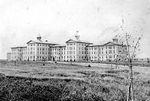Difference between revisions of "Portal:Featured Article Of The Week"
M-Explorer (talk | contribs) |
M-Explorer (talk | contribs) |
||
| (7 intermediate revisions by the same user not shown) | |||
| Line 1: | Line 1: | ||
{{FAformat | {{FAformat | ||
| − | |Title= | + | |Title= Elgin State Hospital |
| − | |Image= | + | |Image= Elgin.jpg |
|Width= 150px | |Width= 150px | ||
| − | |Body= The | + | |Body= The original name of the Elgin Mental Health Facility (its current name) was The Northern Illinois Hospital and Asylum for the Insane. The doors opened in 1872, however, construction of additional buildings continued until 1874. A rumor circulated for year, and still exists that the State of Illinois approached the City of Elgin with plans to construct a mental institution and a college and offered Elgin one or the other. As the rumor goes, Elgin took the mental institution, De Kalb took Northern Illinois University. As Elgin Historian and celebrated Elgin History author, Bill Briska points out the rumor, "...is totally false" He goes on to state that, "The state hospital was founded in 1869 and the college in 1892. (there are ) No connection between the events". |
| − | + | The man-made lake was added in 1886. It was 400 by 500 feet in area and was designed to create a tranquil atmosphere for the patients and employees, as well as provide extra water for fire protection. In 1949, the census was 6, 025. In 1955, the average daily census was 7,644, its peak number of patients. Through the years, the hospital was often involved with notable research in medical and behavioral advances and served as a training ground for many physicians and other disciplines as mental health services were coming of age. In the early 1950's, with the advent of major pharmacological treatment alternatives, the move to deinstitutionalize mental health services began and, by 1965, the hospital’s average daily bid census dropped to 5, 103. [[Elgin State Hospital|Click here for more...]] | |
}} | }} | ||
Revision as of 03:08, 18 October 2020
Featured Article Of The Week
Elgin State Hospital
The original name of the Elgin Mental Health Facility (its current name) was The Northern Illinois Hospital and Asylum for the Insane. The doors opened in 1872, however, construction of additional buildings continued until 1874. A rumor circulated for year, and still exists that the State of Illinois approached the City of Elgin with plans to construct a mental institution and a college and offered Elgin one or the other. As the rumor goes, Elgin took the mental institution, De Kalb took Northern Illinois University. As Elgin Historian and celebrated Elgin History author, Bill Briska points out the rumor, "...is totally false" He goes on to state that, "The state hospital was founded in 1869 and the college in 1892. (there are ) No connection between the events".
The man-made lake was added in 1886. It was 400 by 500 feet in area and was designed to create a tranquil atmosphere for the patients and employees, as well as provide extra water for fire protection. In 1949, the census was 6, 025. In 1955, the average daily census was 7,644, its peak number of patients. Through the years, the hospital was often involved with notable research in medical and behavioral advances and served as a training ground for many physicians and other disciplines as mental health services were coming of age. In the early 1950's, with the advent of major pharmacological treatment alternatives, the move to deinstitutionalize mental health services began and, by 1965, the hospital’s average daily bid census dropped to 5, 103. Click here for more...
